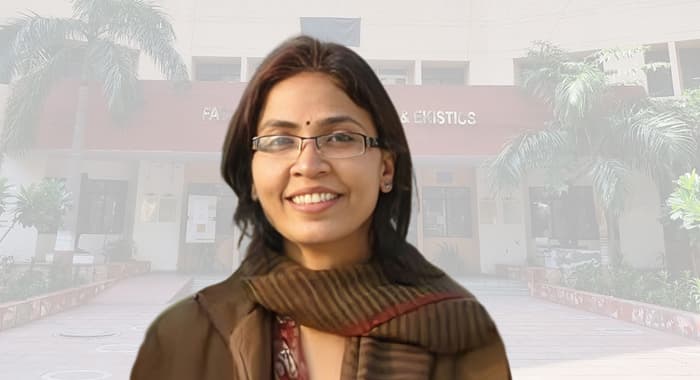Architecture isn’t just about buildings; it’s about people, assures Prof. Hina Zia, Dean of the Department of Architecture at the Jamia Millia Islamia University in Delhi. In an exclusive interview with Education Post’s Prabhav Anand, she talks at length about navigating educational policies like the National Education Policy (NEP) 2020, embracing multidisciplinary approaches, and fostering industry-academia collaboration through initiatives like the Professor of Practice (PoP) program.
Q. Reflecting on the inception of Jamia’s Department of Architecture 2001, please elaborate on the journey of the department, highlighting key milestones and the reason that steered its establishment as a sheet of excellence in architectural education?

Looking back from where we started in 2001 to where we are now, it’s pretty amazing. We kicked off the Department of Architecture as a small part of the Faculty of Engineering and Technology. Professor Sikandar Nabi was instrumental in getting the ball rolling. It wasn’t easy, establishing a separate faculty for architecture. But we pushed through, and by 2006, with the tireless efforts of our founding Dean, Professor S.M. Akhtar, we became the first central university to have our own standalone faculty of architecture.
Now, what’s really cool about Jamia Millia Islamia is our history tied to the nationalist movement. We’re all about inclusive education, and that spirit flows right into our approach to architecture. We’re not just about flashy buildings for the elite; we’re about designing spaces that meet the needs of everyone. That’s been our motto from day one.
And speaking of our curriculum, it’s a real mixed bag. We blend in sociology, behavioral science, technology – you name it. Because architecture isn’t just art or science; it’s a bit of both. We want our students to think outside the box, to understand the people who’ll be using the spaces they design.
And let’s not forget about breaking stereotypes. We welcomed students from all sorts of backgrounds into our department. It’s all about that multidisciplinary approach, which, by the way, is a big buzzword in education these days. We want to produce architects who can create spaces that make people feel good, whether they’re chilling in a park or hanging out in a building.
Q. With the introduction of these various programs, including the Bachelor of architecture, Master of architecture, and Ph.D. in IT department, how has the department evolved to meet the changing demands of the profession of architecture?
Our programs, which encompass the Bachelor’s degree, as well as a variety of Master’s and Ph.D. offerings, have undergone significant evolution to remain relevant in today’s architectural landscape. Our guiding principle has always been to make architecture accessible to the masses, a notion that has shaped the trajectory of our curriculum and program development.
Since the inception of our Master’s programs in 2003, followed by subsequent additions in 2006 and 2008, including the recent establishment of the Departments of Planning and Design and Innovation, we’ve consistently responded to the changing needs of society. This responsiveness is evident in the diversity of our offerings, from specialized courses in recreation architecture to urban regeneration and healthcare architecture.
For example, the introduction of healthcare architecture courses was a direct response to the complex demands of designing healthcare facilities, ranging from small nursing homes to large multispecialty hospitals. Feedback from industry practitioners played a crucial role in shaping these programs, ensuring that our graduates are equipped with the skills and knowledge needed to excel in their careers.
We’ve also been proactive in integrating emerging concepts such as ecology, environment, and sustainability into our curriculum, long before they became focal points in national and international policies. By staying attuned to societal needs and trends, we’ve been able to maintain a pulse on the evolving architectural landscape.
Moreover, the recent expansion of our department with the addition of departments like Planning and Design and Innovation further enhances our ability to address contemporary challenges. This expansion is not merely about broadening our academic offerings but also about deepening our commitment to accessible education.
Our affordable fees make quality architectural education attainable for students from diverse socioeconomic backgrounds. This affordability, coupled with our emphasis on excellence, has contributed to our consistent national rankings and the success of our graduates in securing rewarding positions in the field.
Ultimately, our evolution as a department is rooted in the fundamental ethos of Jamia Millia Islamia – a commitment to inclusive education and societal betterment. It’s a collective effort, driven by the dedication and vision of our faculty, staff, and students, all working towards a common goal of creating a more responsive and inclusive architectural education landscape.
Q. How does the department ensure that students develop a profound understanding of the diverse aspects of human experiences, as well as responsiveness to nature, society, and the nation, according to sustainable development? How does the student develop that understanding?
The department ensures students develop a profound understanding of diverse human experiences, societal responsiveness, and sustainable development through a multifaceted approach. Firstly, the pedagogy emphasizes practical learning, integrating theoretical knowledge with real-world application. For instance, programs like public interest design immerse students in live projects, fostering sensitivity to community needs and environmental concerns from an early stage.
Additionally, technological advancements are integrated into the curriculum to equip students with modern tools and methodologies. By exposing students to societal realities through various projects and engagements, the department cultivates a mindset geared towards addressing public demands and societal needs. Furthermore, the department’s location in a diverse urban environment provides students with first-hand exposure to a range of challenges, from planned settlements to densely populated areas and urban villages.
Q. What are some highlights and challenges the faculty of architecture and acoustics in your department has faced, and what strategies and solutions have been implemented to overcome them?
Challenges are universal for architecture colleges, whether government or private, they are all universal. So architecture departments, like any other practice-oriented department, need a lot of funds to maintain the infrastructure to keep pace with the introduction of new instruments like 3D printers, bigger ones, CNC machines, laser printers, all these things, or even updating your licenses for all those BIM software, Revit, although they do provide the educational version free of course to the students.
But a lot of these updates are required and even your systems and labs need to be updated every couple of years. So funds are one universal challenge that is faced by everybody, including IMS and SPAs. So we are no exception. We have been working on this, so we keep sending requests to our higher authorities. So in bits and parcels, we do get sometimes it is a delayed thing, but that’s one of the challenges.
The other thing is that despite this high inflation and the need for regular updating of the infrastructure, which requires not just updation but also maintenance cost, we are told that increase your fees, which we are very apprehensive of increasing the fees because of the kind of masses we get, the kind of large number of students we get. We think that as long as we can delay that, let us delay that because otherwise it might become very cost prohibitive for a lot of students who will otherwise drop the idea and they will not come to architecture and they will destroy any other branch which is a lesser feast. So this is an ongoing thing.
We also, like so many other architectural colleges and schools, feel that more faculty, more practitioners, more visiting faculty, but our higher authorities have always been. We are fortunate to have very supportive higher authorities. All vice-chancellors have been very supportive and they have been kind enough to give consent to whatever request we send them. There are many visiting faculty and experts we need to teach across different programs and courses. These are two things I would like to highlight.
Q. Talking about the technology, as we just talked about technology, it plays a major role in improving students’ learning ability. How can artificial intelligence (AI), virtual reality (VR), and other new technologies be integrated into the curriculum to enhance it and prepare students for the evolving demands of the architectural profession in the future?
Technology indeed plays a significant role in enhancing students’ learning abilities. Across major reputable architecture colleges, AI and VR have gained acceptance due to their undeniable importance in the field’s future. Students and younger faculty members have embraced these technologies, recognizing their potential to streamline tasks and enhance creativity.
AI and VR can complement students’ creative endeavors by providing supportive tools and prompts. However, it’s crucial to emphasize that creativity must stem from within. While technological tools can aid in visualization and efficiency, they should not replace the core creative process. Therefore, we integrate these technologies judiciously, ensuring that students understand their role as supportive tools rather than substitutes for creativity.
In our curriculum, we encourage creativity through hands-on studio exercises, where students work with traditional mediums alongside technological tools like SketchUp and 3D modeling software. These tools help students visualize their ideas more effectively, but we also emphasize the importance of manual sketching and conceptual design processes.
We engage students in open debates about the role of technology in architecture. We highlight that while AI can assist in certain tasks, it cannot replace the creative and technical skills that define a successful architect. By nurturing students’ inherent creative abilities and technical skill sets, we prepare them to navigate a future where AI plays an increasingly prominent role in the profession.
Ultimately, our goal is to empower students to leverage technology as a tool to enhance their creativity and efficiency, rather than relying on it as a crutch. By striking a balance between traditional design processes and innovative technologies, we ensure that our graduates are equipped to thrive in an evolving architectural landscape.
Q. Considering the dynamic nature of educational policies, how has your department navigated recent changes and what are your thoughts on the future direction of this department, on architectural education, both within the institution or on a broader scale?
Considering the dynamic nature of educational policies, including the NEP and upcoming reforms, our department operates within the broader framework of higher education institutions. As a part of Jamia Millia Islamia, a prominent central university, we adhere to directives from both the Council of Architecture and the UGC.
While standalone architecture colleges are primarily guided by the Council of Architecture, being part of a central university subjects us to additional oversight from the UGC. We anticipate changes in line with the NEP 2020, such as the proposed shift to a three-plus-two or three-plus-one system for professional examinations, although definitive decisions are pending.
Already, our university has embraced elements of the NEP, such as the adoption of NPTEL and SWAYAM courses and the implementation of CBCS. Multidisciplinary approaches, integral to the NEP, have been incorporated to the extent permissible within the architecture curriculum, striking a balance between UGC and Council of Architecture requirements.
At Jamia, the introduction of the PoP initiative by the UGC is a notable step towards enhancing academicindustry collaboration. While PoP appointments are not yet widespread across other institutions, our department benefits from the expertise of visiting experts in architecture, planning, design, and innovation.
We are mindful of broader national priorities, particularly regarding urban planning and climate resilience. With the increasing focus on urban development and climate change adaptation, we consciously integrate relevant topics into our curriculum and design briefs. For instance, we address the need for master plans in urban areas and emphasize building resilience against natural disasters, given the vulnerability of densely populated regions like India’s metros.
In navigating these changes, our department remains committed to providing a comprehensive architectural education that prepares students to address contemporary challenges and contribute meaningfully to the built environment.

Q. Considering the unequal quality of architectural education across colleges in India, should students who do not get admission into good colleges have the option to choose an apprenticeship model instead of going to a private institution or school? They could learn practical skills from a mentor or a prominent architect. What are your views on that?
There was a time when a lot of new architectural schools came up all across the country without having the necessary faculty and infrastructure. However, the Council of Architecture took cognizance of this and closed several such schools with serious lapses observed in meeting the mandatory conditions put forth by the Council. So there is no longer a rosy picture for architectural schools to get approvals without adequate facilities/faculty. The rage for admissions in the B.Arch. program depends on the real estate market status of the time (and the latter depends again on the international markets, political stability, policies, general economic conditions, etc.).
If there is a boom, budding architects get easily placed both for internships and jobs. For instance, the students faced difficulty in completing their internships during COVID-19 times and now the Indian real estate market is again up so there is a lot of demand for architects. The apprenticeship model was prevalent during the medieval times and was replaced by the (now popular) studio model. To my understanding, the internship is apprenticeship but what you are suggesting is to have a parallel model of learning by apprenticeship only. To a certain extent, the parallel system does exist wherein the diploma students are eligible to get a B.Arch. equivalent degree based on experience gained through apprenticeship/work experience and qualifying for the exams conducted by IIA.













